Facing a drug overdose crisis, Seattle is poised to join Vancouver as the second city in Cascadia with a safe injection site
Turina James knows a thing or two about opioid addiction. Born in Yakima, she was a runaway at the age of twelve, and by fifteen she was hooked on heroin and cocaine. Then she became pregnant. But soon after an arrest, James was sent to a holding cell, and that time off drugs started the process of ending her addiction. James stayed clean for many years afterwards. But taking oxycodone as a pain medication after surgery in 2005 sent her spiraling into an addiction to painkillers—and eventually to heroin once again. “I met the wrong person at the wrong time,” James says.
In that second round of addiction, she found herself homeless in Seattle, sleeping in alleyways and on sidewalks downtown. She scraped money together to buy drugs, shooting up wherever she could. Unsanitary injections ended up giving her a nasty strep infection that eventually spread to her neck. James underwent major surgery to repair damage to two upper vertebrae shattered by the untreated infection.
James was lucky, though. Thanks to the help of an exceptional case worker, she got herself into detox and through methadone, she broke free of addiction. Now she speaks up for the rights of people struggling with substance abuse, sharing what her experience was like. “People don’t really understand it until they see it,” she says.
Like many people addicted to heroin, James’ search for a place out of sight to get high often led to life-threating situations like the infection that nearly killer her. “You use anywhere you can,” James says. “In the bathroom at restaurants, in parks.” She sometimes broke off needles in her arm, and several times had to have them surgically removed.
For those who don’t have shelter and face heroin addiction, James’ story is a familiar one. And because of these concerns, and a rising overdose death rate in King County and Seattle, a county task force in 2016 recommended a range of new approaches to opioids, including expanded prevention and treatment efforts, widespread availability of naloxone kits to treat overdoses, and—most controversially—the creation of two sites in the county where substance abusers could inject opioids under the supervision of trained health care providers.
After the the task force released its report, the Seattle city council budgeted $1.3 million to determine the location and scope of two pilot sites for safe injection—one inside the city limits, and one outside the city elsewhere in King county. At such sites—also known as CHELs (Community Health Engagement Locations), those addicted to drugs could safely get high without fear of arrest and in the presence of trained medical professionals on standby to ensure they don’t die in the event of an overdose.
public health officials suggested that because of high real estate costs and the fact that no Seattle neighborhoods were actively welcoming an injection site, the city is now leaning toward a “fixed mobile” injection site located in a van that could be moved if needed.
The opioid drug overdose crisis has been raging across North America in the past decade, and Seattle hasn’t been immune. The King County Medical Examiner’s (KCME) Office reported that drug overdose deaths increased to their highest levels in 2016 for both Seattle and King County. Opioids caused the majority (63 percent) of the 360 deaths that year.
The search for locations for the two safe injection sites has sparked a heated debate. An outspoken opponent of safe injection, state senator Mark Miloscia (R-Federal Way) introduced a bill in the legislature to prohibit safe injection across Washington state. In addition, King county residents gathered signatures to put Initiative 27 on the ballot, which would outlaw safe injection throughout the county. But before it could be put to a vote, it was struck down by the King County Superior Court. In her ruling, the judge claimed the measure would violate a state law that gives public health officials wide latitude to improve health outcomes. An appeal is pending in the Washington State Supreme Court.
Finding locations has been problematic, and several cities outside of Seattle passed local ordinances banning safe injection sites, including Renton, Federal Way, Burien, and Auburn. In the face of this opposition, the Seattle Public Health Department changed course and announced earlier this year that there would only be one site, located within city limits.
At a presentation to the Seattle city council’s housing committee in early June, public health officials suggested that because of high real estate costs and the fact that no Seattle neighborhoods were actively welcoming an injection site, the city is now leaning toward a “fixed mobile” injection site located in a van that could be moved if needed. Less controversial services such as treatment, therapy, and medical consultation could occur in a nearby permanent location.
Safe injection sites have already been introduced in dozens of cities in Europe and Australia, and studies have found these facilities can dramatically reduce the incidence of fatal drug overdoses. Other cities in the US are investigating the creation of safe injection sites, including Philadelphia, Ithaca, Denver, and New York. San Francisco announced it plans to open safe consumption centers by August of this year. But the Trump administration has muddied the waters by claiming that such sites violate federal law.
Here in Cascadia, one city has had a long experience with safe injection: Vancouver, British Columbia.
Activists there managed to create North America’s first safe injection facility—Insite—fifteen years ago, in the city’s Downtown Eastside neighborhood, where many addicts without shelter live. Creating the facility involved a long, protracted battle to gain legal recognition from the BC provincial and Canadian governments.
A front row view of Vancouver’s addiction epidemic
Travis Lupick, a reporter for The Georgia Straight in Vancouver, has long reported on the addiction crisis. He saw firsthand what the situation was like before the implementation of safe injection sites.
“I live in the Downtown Eastside,” Lupick says. “There’s been more than a couple people I’ve interviewed who I learned died later.”
Lupick watched the epidemic rise 1990s and early 2000s. Approximately 200 people were dying each year in Vancouver by the time Insite opened in September 2003. The facility does not provide its clients with drugs, but does provide clean supplies, medical personnel on standby, and naloxone kits in the event of an overdose. By 2017, Insite had provided clients with over 175,000 visits, an average of 415 per day.
If the alternative is letting these people die, I would argue it’s worth spending the money.
After seeing so many people struggle on the street, sometimes passed out or even dead, Lupick felt a duty to keep reporting on the epidemic. It’s seen a dramatic transformation in the past few years.
“Any time someone is using a health care service, they are a burden on that service,” Lupick says of one argument against safe injection sites. “But it doesn’t mean that we even think twice about providing them with medical care. If the alternative is letting these people die, I would argue it’s worth spending the money.” Lupick adds that unsupervised injection includes many hidden costs—everything from emergency room visits to amputations, and expensive medications for Hepatitis C and HIV.
(To learn more about the history of the effort to create Vancouver’s first safe injection site in 2003, read an excerpt from Travis Lupick’s book Fighting For Space at Cascadia Magazine).
“It can be hard to report on a topic like this for so long when it can sometimes appear like such an inadequate response,” Lupick says. “At the same time, I’ve heard so many amazing stories of marginalized communities rallying together and taking matters into their own hands and responding in many ways without the government. It’s an inspiring story of empowerment.”
But Insite—which Seattle public health officials have been studying as their model—didn’t start easily. It was an uphill battle between activists and the provincial and federal governments. Legal status was tenuous for many years. In 2003, the regional health authority in Vancouver successfully applied to the federal government for a legal operating exemption to pilot North America’s first medically Supervised Injection Facility (SIF). But after the Conservative Party won elections at the federal level in 2006, government officials threatened to revoke the site’s legal status. The dispute made its way through the court system until Canada’s Supreme Court ruled in favor of Insite’s exemption from drug prohibition laws in 2011.
“The government only went kicking and screaming,” Lupick says. “It was a fight just like it is in Seattle right now. It was a fight led by activists. It was activists and drug users and community taking care of itself that led to Insite’s establishment, and I think you’re seeing the same story happen in Seattle.”
Canadian premier Justin Trudeau ultimately declared a public health emergency in April 2016, allowing injection sites to expand. Canadian taxpayers now fund several sites located in the center of the troubled Downtown Eastside neighborhood, where drug use continues at epidemic proportions. City officials say there are about 3,000 users in a 10-block area.
There are currently nine supervised consumption and overdose prevention sites in Vancouver. (To see what happens at the Overdose Prevention Society’s safe consumption and site in the Downtown Eastside, view Jackie Dive’s photo essay at Cascadia Magazine.)
Opposition to safe injection in Seattle—and in British Columbia—includes worry that drug dealers will use places like Insite as a hub to sell their product, or that the site itself enables drug use. Opponents tend to see addiction as a poor life choice, and their arguments lean toward continued support for North America’s war on drugs. Even drug users themselves, however, don’t deny that safe injection sites essentially enable their habits. The real difference these facilities make is regularly saving lives.
“At its core, a safe injection site is safe space where people who use drugs, who are addicted to drugs, can exist without fear of persecution or fear of death,” Lupick says. It’s where addicts are allowed to exist and be seen in the realities with which they operate, free of judgment and criminalization without having to hide in bathrooms, or inject with and discard unclean needles in public spaces.
“The question of whether or not we should apply health care service to drug users is more a question of ideology,” Lupick says. “If you’re going to take the position ‘drug users are allowed to die,’ that’s your right. But I’ve never encountered it from somebody who has a close family member struggling through addiction. All it takes is a bit of empathy, thinking of all drug users as our family members who use drugs.”
One notable difference between Vancouver’s activists and Seattle’s is that Seattle supporters prefer the creation of “safe consumption spaces,” (SCS), so that sites aren’t specific simply to injection.
Seattle activists push to save lives
Seattle already has a robust needle exchange program where multiple cubbies around King County hold sterile needles and disposal bins for discarding used ones.
“Injection sites are injection only. Consumption sites are open to other modes of intake like inhalation, which is much safer,” says Patricia Sully, coordinator of the Seattle activist group Yes to SCS. “The Task Force recommended consumption if possible, but ultimately the city and county will decide the model.”
Sully points out two primary reasons for giving preference to a consumption sites over the injection-only model: racial disparity and safety. Historically, the war on drugs focused a lot of police attention on crack cocaine, which is a relatively cheap drug that’s primarily inhaled. Studies have established that arrest rates, conviction rates, and prison sentences for crack cocaine (used primarily by people of color and those with low incomes) are at rates up to 100 times that of other drugs such as powder cocaine. Safe consumption sites offer a safe space to inhale drugs such as crack cocaine in addition to providing safe injection of heroin.
“These need to be open to everyone,” Sully says. “It also doesn’t make sense to bring that person into the continuum of care, have them take a positive public health step and move to inhalation, and then send them back out to the alley.”
We know arresting that person and sending them through the system is really expensive and really ineffective. Telling them to just stop doing drugs immediately doesn’t work, or else we wouldn’t be where we are right now.
Sully was a part of King County’s Heroin and Opiate Addiction Task force, the same one that recommended the creation of two safe injection sites. The model recommended by the Task Force is closer to a fully exempted site with a robust service model for a variety of addictive substances, Sully says.
“Although Vancouver deserves praise for opening Insite it also deserves criticism for only opening Insite,” Lupick says, sending a word of caution to Seattle on its choices. “For 15 years, there was only one injection site. There was still an entire province of people who didn’t have access to that same space.”
Sully agrees that a variety of facilities would better address a complicated problem. “As we move forward, we should think about how we co-locate these with existing service providers,” Sully says. “It makes sense that eventually we would be moving in a direction of scatter site models that look different depending on the needs.”
“There’s this real problem where there’s just not a good option,” Sully says. “Whether it’s a case manager or a law enforcement officer, the best option anyone really has when addressing someone who is using drugs in public is ‘go somewhere else.’ We know arresting that person and sending them through the system is really expensive and really ineffective. Telling them to just stop doing drugs immediately doesn’t work, or else we wouldn’t be where we are right now. There’s no other option for them other than ‘please be less visible,’ which makes them less safe. If they do that, nobody is going to revive them or nobody is going to get them enough help.”
Sully is impressed and enthusiastic about support for safe consumption spaces in Seattle, saying the group gets supportive emails every day. Residents, people who have lost a loved one, health care workers, and drug users themselves—including Turina James—have come together to advocate for safe consumption sites and participate in everything from protest die-ins to education events.
“That activism really crosses so many different lines,” Sully says. “We have so many parents, people in recovery, health care workers, and neighbors who are engaged in sharing their stories. It’s really mind-boggling that we’ve been doing this for two and a half years and a site is still not open. Something this vital and life-saving should move so much faster than it is.”
She understands that both opposition and proponents of SCS are primarily concerned about balancing the health of drug users with the impact these facilities have on the local neighborhood. But getting to a solution that opponents and supporters can agree on is a tricky prospect.
“People are healthier and safer when they have more choices,” Sully says. “There is often this concern that we should put all this money into treatment. But the reality is, treatment is necessary but not sufficient. Substance use disorder is a chronic relapsing condition. [SCS] occupies a really important space where prevention has failed and treatment is not yet sought. That person needs to be in a space where they can make healthier choices for themselves where they are, and that’s exactly what syringe exchanges do, and exactly what safe consumption spaces do. So many people experience so much stigma everywhere they go and they can’t talk to people about their lived reality. [SCS] is a place where people can actually be who they are, where they can talk to their nurse about being a drug user and won’t be judged for it. That’s a transformational, relationship-building step with a health care provider.”
Safe consumption: benefits and tradeoffs
Before Insite launched—and, in part, to convince officials—activists pushed for research that led to the Vancouver Injection Drug Users Study (VIDUS), a cohort study of injection drug users that began in 1996. It investigated how safe injection affects Injection Drug Users (IDUs) who use it. The study also looked at risk behaviors such as syringe sharing and overdose.
The drug use behaviors of 871 IDUs were observed one year before and one after Insite’s opening. The researchers found there was an increase, one they deem unsubstantial, in the rate of relapse among former users (it was 17 percent prior to Insite’s opening and 20 percent after). There was also “no substantial” decrease in the rate of recovery among current users (17 percent prior; 15 percent after). The upshot is that Insite reduced incidence of high-risk behaviors and increased public order (since users were no longer consuming on the streets) but it also contributed to a small uptick in Vancouver’s drug use patterns.
The number of overdose deaths in British Columbia has surged, claiming 935 lives last year and 488 in the province so far this year.
The VIDUS authors also looked at data, before and after Insite opened, from the Vancouver Police Department on drug trafficking, assaults, robberies, vehicle break-ins, and thefts. Researchers found no statistically significant changes—meaning nothing more than what’s mathematically attributed to pure chance, rather than correlation or causation—in rates of drug trafficking. There was, however, a statistically significant drop in vehicle break-ins and vehicle thefts. The results of this study provide evidence that Insite has not contributed to an increase in drug-related crime in surrounding neighborhoods.
Moreover, Insite unexpectedly benefited female and LGBTQ drug users. The site provided temporary refuge from the dangers of the street-based drug scene. Often, women would be introduced to drugs through men and couldn’t inject themselves, sometimes forcing them to rely on abusive men who did not how to inject properly or safely, leading to overdoses and other associated medical issues.
Studies also found IDUs who use Insite are 70 percent less likely to share syringes than IDUs who do not use the facility. The IDU population has also seen the rate of HIV and Hepatitis C plummet since Insite opened.
“In banning safe injection sites, it would prevent the launch of an evidence-based prevention to protect public health safety, save lives and engage users of opiates,” said Brad Finegood of King County Community and Health Services, testifying in favor of safe injection sites at the Washington state legislature in 2017.
Saving lives is a primary mission at Insite, which has a staff of 10—including three nurses. Clients bring in their own drugs and inject them in one of 13 mirrored booths before moving to a lounge area. Others visit the site to access health care, counseling, or inquire about treatment programs. By 2015, Insite staff intervened in 4,922 overdoses using naloxone without a single death.
The positive change is so apparent that even a skeptical Vancouver cop-turned-inspector, Bill Spearn, changed his mind on the matter. Unfortunately, he’s also seen overdose deaths spike beyond the levels seen in the 1990s, which first spurred Insite’s creation. The number of overdose deaths in British Columbia has surged, claiming 935 lives last year and 488 in the province so far this year.
This begs the question: Did Insite actually make a difference?
The new threat: Fentanyl
The new increase in overdose deaths in North America is related to a profound change the drug landscape. Eighty percent of the overdose deaths in British Columbia in the past two years were caused by fentanyl, a new, far stronger opioid. Fentanyl often gets laced with other opioids, unbeknownst to drug users. The Drug Enforcement Administration (DEA) lists fentanyl as 50 times more potent than heroin.
“Unfortunately it’s a very dangerous opioid,” Lupick says. He recalled the winter of 2016 as a “really scary time” where monthly overdoses increased from about 20 to 140 incidents. “We didn’t know what was happening. We learned later that it was carfentanil [which is used as tranquilizers for elephants]. It was literally tangible. You could see the increase in communities. I would pass by overdoses on my way to work in the morning. I would be in Downtown Eastside interviewing someone about overdoses, and 10 feet away someone would overdose, and the interview had to be stopped to address it.”
When excluding fatal fentanyl-detected overdoses, the number of fatal overdoses (around 290) have remained relatively stable since 2011 in British Columbia, according to the Coroner’s Service. A review of completed cases from 2016-17 indicated fentanyl as the most frequent cause of overdose deaths, sitting at 72 percent. Preliminary data suggests the proportion of overdose deaths for which fentanyl was detected (alone or in combination with other drugs) was approximately 84 percent in 2017 and 83 percent in 2018.
Likewise, the KCME Office found a significant increase of synthetic opioids—such as fentanyl, fentanyl-related compounds and U-47700—among the 360 overdose deaths from 2016. King County’s increased fentanyl use isn’t as dramatic as British Columbia’s, however. Heroin and prescription opioids far outpaced fentanyl in 2016. However, the number of those who fatally overdosed on fentanyl and other synthetic opiates more than doubled for the entire U.S. in just one year, according to the Center for Disease Control—leaping from from 9,580 in 2015 to 19,413 in 2016.
In September 2016, the DEA issued a public warning in Washington state, saying carfentanil is 10,000 times more potent than morphine and 100 times more potent than fentanyl. “The DEA, local law enforcement and first responders have recently seen the presence of carfentanil,” their warning stated. Carfentanil and its cousin can come in several forms, including powder, blotter paper, tablets, and spray – and can be absorbed through the skin or accidental inhalation of airborne powder.
“Carfentanil is surfacing in more and more communities.” said DEA acting administrator Chuck Rosenberg. “We see it on the streets, often disguised as heroin.”
You can’t get clean if you don’t have a place to lay down your head at night and a place to wash your ass.
While safe injection facilities like Insite or the proposed Seattle SCS can help prevent overdoses, but there’s little they can to do ensure a user’s drugs aren’t laced with dangerous substances like carfentantil. As a result, some activists in British Columbia are pushing for even more radical steps. A pilot program of prescribed heroin and hydromorphone exists at Crosstown Clinic, one of Vancouver’s safe consumption sites. It’s a controversial approach, but it does ensure the drugs consumed aren’t full of deadly chemicals.
Addtionally, responding to the jump in overdose fatalities, Vancouver mayor Gregor Robertson announced earlier this year that he supports broad decriminalization of drugs—including heroin—in order to focus on the problem as a public health concern rather than a criminal justice matter.
In the meantime, Seattle waits to hear from the courts and public health officials about whether the city will become one of the first in the US to create a safe consumption site.
Turina James is grateful she had the opportunity to get clean and end her addiction. Others aren’t so lucky, and James has seen many of her friends die. Protecting lives is why she speaks out for affordable housing and safe injection sites. Some people, James concedes, will never escape their addiction. But having a safe space can save lives and offer a place where someone willing to begin treatment can make those first steps. Living on the street and injecting on the street makes that journey much more difficult.
“You can’t get clean,” she says, “if you don’t have a place to lay down your head at night and a place to wash your ass.”
“Every human being deserves that. They need their dignity.”
Kelsey Hamlin is a freelance journalist who lives in Seattle. Her work has appeared in The South Seattle Emerald, International Examiner, Curbed, and Seattle Weekly.
Some reporting for this story was provided by Andrew Engelson.
.
.
.
.
.
.
.
.
About the photos
In response to Vancouver’s drug overdose crisis, activists Ann Livingston and Sarah Blyth worked to open the Overdose Prevention Society site in the city’s Downtown Eastside in September 2016. The goal is to provide a safe space for drug users to consume under the supervision of trained volunteers who can provide naloxone or oxygen in the event of an overdose. OPS is also unique in that it provides a safe inhalation site where users of drugs such as crack cocaine aren’t forced to consume on the streets. The site’s innovative approach is being modeled by other safe consumption sites across Vancouver.
The OPS site is also unique in that it’s run and staffed by peers–people with lived experience of addiction. The majority of staff are active users, and they’re paid a small honorarium the following day. In this way, OPS gives meaningful work to people who might otherwise have to resort to hustling, which is often when high risk behaviour happens (sex trade, property theft, and violence).
For the photo essay above, Vancouver-based photographer Jackie Dives was allowed access to the OPS site and asked to respect the privacy and dignity of clients by not photographing people actively using. She was able to meet and interact with the staff and listen to their stories–most of whom currently live with addiction.
(To learn more about the history of the effort to create Vancouver’s first safe injection site in 2003, read an excerpt from Travis Lupick’s book Fighting For Space at Cascadia Magazine).
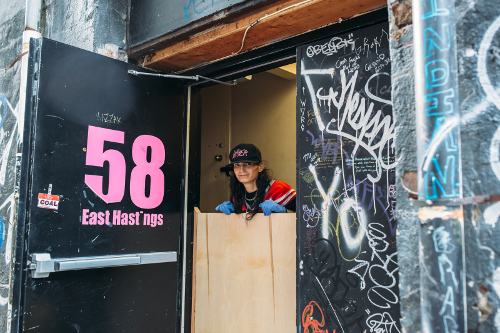
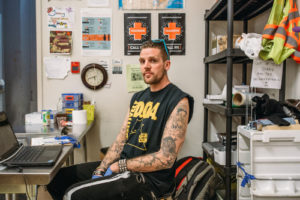
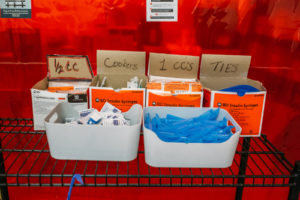
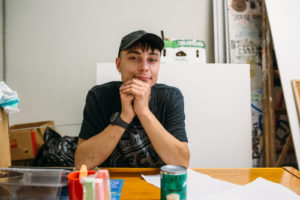
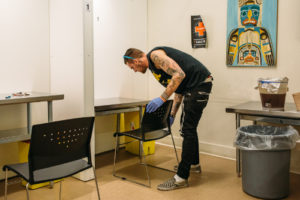

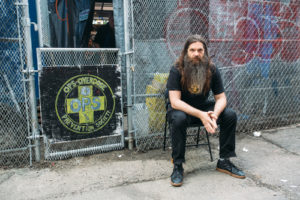
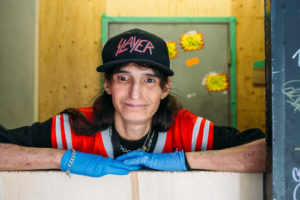
Jackie Dives explores themes of identity and womanhood through the medium of digital and analog photography. Self-taught, Dives began taking photographs as a way to deal with her experience living with anxiety and depression. While working as a doula she began photographing women giving birth and this led to her interest in documenting social justice issues through the lens of the female gaze. Inspired by photographers Nan Goldin, Francesca Woodman, and Mary Ellen Mark, Dives’ photographs are diaristic, vulnerable, and sometimes confrontational. Her work has been published internationally in publications that include Canadian Geographic, The Tyee, VICE, The Globe and Mail, and Maclean’s.
If you found this article informative, please consider making a donation today. Cascadia Magazine is a reader-supported publication, and we rely on the generous financial support of readers like you to publish great journalism on issues that matter to the Pacific Northwest.
